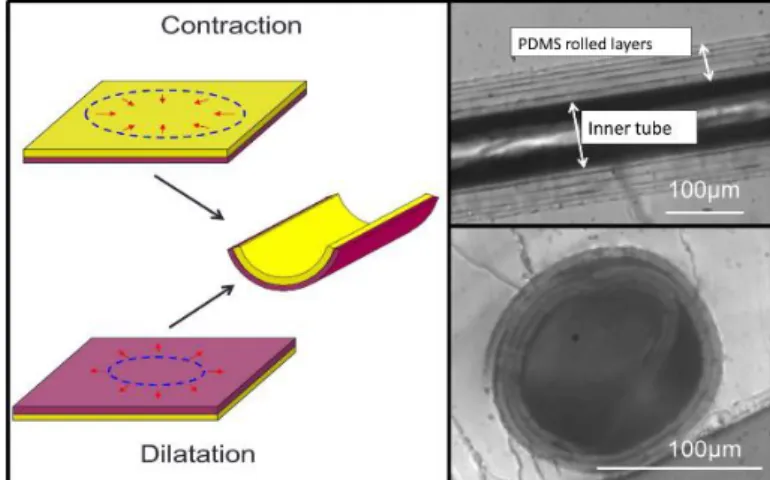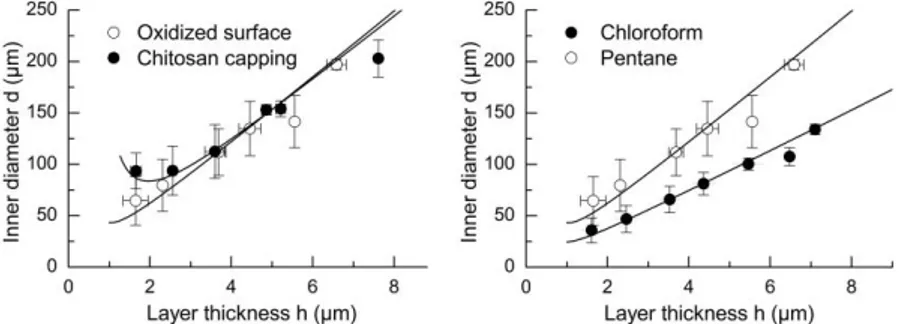HAL Id: cea-02351501
https://hal-cea.archives-ouvertes.fr/cea-02351501
Submitted on 6 Nov 2019HAL is a multi-disciplinary open access archive for the deposit and dissemination of sci-entific research documents, whether they are pub-lished or not. The documents may come from teaching and research institutions in France or abroad, or from public or private research centers.
L’archive ouverte pluridisciplinaire HAL, est destinée au dépôt et à la diffusion de documents scientifiques de niveau recherche, publiés ou non, émanant des établissements d’enseignement et de recherche français ou étrangers, des laboratoires publics ou privés.
Self-rolled microsystems: a promising route toward fully
functionalized and low-cost micro-capillaries
R. Brossard, V. Luchnikov, P. Guenoun, F. Malloggi
To cite this version:
R. Brossard, V. Luchnikov, P. Guenoun, F. Malloggi. Self-rolled microsystems: a promising route toward fully functionalized and low-cost micro-capillaries. MicroTAS, Oct 2016, Dublin, Ireland. �cea-02351501�
SELF-ROLLED MICROSYSTEMS: A PROMISING ROUTE TOWARD
FULLY FUNCTIONALIZED AND LOW-COST MICRO-CAPILARIES
R. Brossard
1, V. Luchnikov
2, P. Guenoun
1and F. Malloggi
1*
1
LIONS, NIMBE, CEA, CNRS, Université Paris-Saclay, CEA Saclay 91191, France
2
Institut de Science des Matériaux de Mulhouse, UMR 7361 CNRS-UHA, France
ABSTRACT
We present a new route for the fabrication of highly specialized micro-capillaries, based on the phenomenon of spontaneous curvature of thin films. Spontaneous rolling is triggered in micrometric PDMS based bilayer thin films by exposure to solvent vapors. First, the influence of the process pa-rameters are investigated. Second, before rolling, the surface can be patterned (chemically, topograph-ically), permitting the fabrication of inexpensive fully functionalized capillaries.
KEYWORDS: 3D Microfluidic, Self-rolling, Functionalization INTRODUCTION
Spontaneous curvature is a well-known instability [1] which occurs in films with gradients of stress along the normal axis. Recently, this effect was used to fabricate tubes as a self-assembly process. Those self-rolled systems have often been cited as object with great potential of application [2].
We focus on the application of those self-rolled microsystems to lab-on-chip technology. We pro-pose methods to induce the spontaneous rolling of polymeric films, more precisely polydimethylsilox-ane (PDMS). The advantage of such system is three-fold: i - Those systems are inexpensive to design. ii - The inner surface of the capillary is accessible before rolling and can be properly functionalized and characterized. iii - The formation of the channel itself is not a lithographic process. Hence, the fabrica-tion of patterned channel are done with only one lithographic step, which implies a great economy in terms of means and efforts.
A method is to harden the surface of a PDMS thin film, either by adding a capping of material (e.g. 60 to 200nm of chitosan) or by hardening the surface by plasma oxidation (some tenth to 100nm of glass like material [3]). The film is then cut and exposed to solvents in gaseous phase [4]. As the swell-ing of PDMS occurs, the flat configuration of the film is not an equilibrium anymore and spontaneous rolling occurs (figure 1). Although the rolling stimulus is isotropic in the film plane, a rolling axis is preferred due to geometrical constraint.
Figure 1. Left: Spontaneous curvature mechanism in a bilayer film, either by expansion of the purple layer, or contraction of the yellow layer. Right: Optical images of rolled systems embedded in PDMS, side and front view.
RESULTS AND DISCUSSION
The inner diameter of those systems can be optically measured. The three main process parameters are investigated. In particular, the total thickness of the film, the type of capping of the film (chitosan or
oxide) and the solvent used to trigger rolling (chloroform, pentane, …) are examined. The inner diam-eter of tubes obtained by varying these paramdiam-eters are plotted in figure 2. Those values are found to match well Timoshenko elastic theory[1] (solid line).
Figure 2. Diameter of rolled tubes as a function of total layer thickness. Left: Influence of capping. Right: Influence of solvent.
In order to illustrate the potential of the method, we proposethe patterning of surface before rolling . With embossing like methods, we obtained capillaries as small as 70 microns with 13 microns deep patterns. With simple stamping methods, chemical patterns as small as 10 µm can be deposited in the tube. In both cases, the pattern covers the whole surface of the tube, which typically cannot be obtained with standard techniques.
Figure 3.Left: Topographical patterning example. 20µm wide and 2.1µm deep pillars. Right: Fluores-cent chemical patterning example. FluoresFluores-cent and optical image of 50µm wide lines.
CONCLUSION
Spontaneous curvature effect can be used for the inexpensive auto-assembly of micro-capillaries. The inner surface of those is fully accessible before the rolling occurs and can be easily functionalized. The main remaining challenge of this technique is the integration of the rolled-up system in a larger microfluidic systems. Methods are developed to obtain soft lithographic / self-rolled hybrid systems in order to make use of the advantages of both processes. We believe in the potential of this method for the design of cutting edge microfluidic technology.
ACKNOWLEDGEMENTS
This work is supported by the French National Research Agency: RUM project-reference ANR-13-ISO9-0002
REFERENCES
[1] Timoshenko, S. et al. J. Opt. Soc. Am 11(3), 233–255 (1925).
[2] Smith, E. J., Xi, W., Makarov, D., Mönch, I., Harazim, S., Quiñones, V. A. B., Schmidt, C. K., Mei, Y., Sanchez, S., and Schmidt, O. G. Lab on a Chip 12(11), 1917–1931 (2012).
[3] Sarrazin, B., Brossard, R., Guenoun, P., and Malloggi, F. Soft Matter, 12, 2200-2207 (2016). [4] Gomez, L. P. C., Bollgruen, P., Egunov, A. I., Mager, D., Malloggi, F., Korvink, J. G., and Luchni-kov, V. A. Lab on a Chip 13(19), 3827–3831 (2013).
CONTACT
* Florent Malloggi: florent.malloggi@cea.fr

